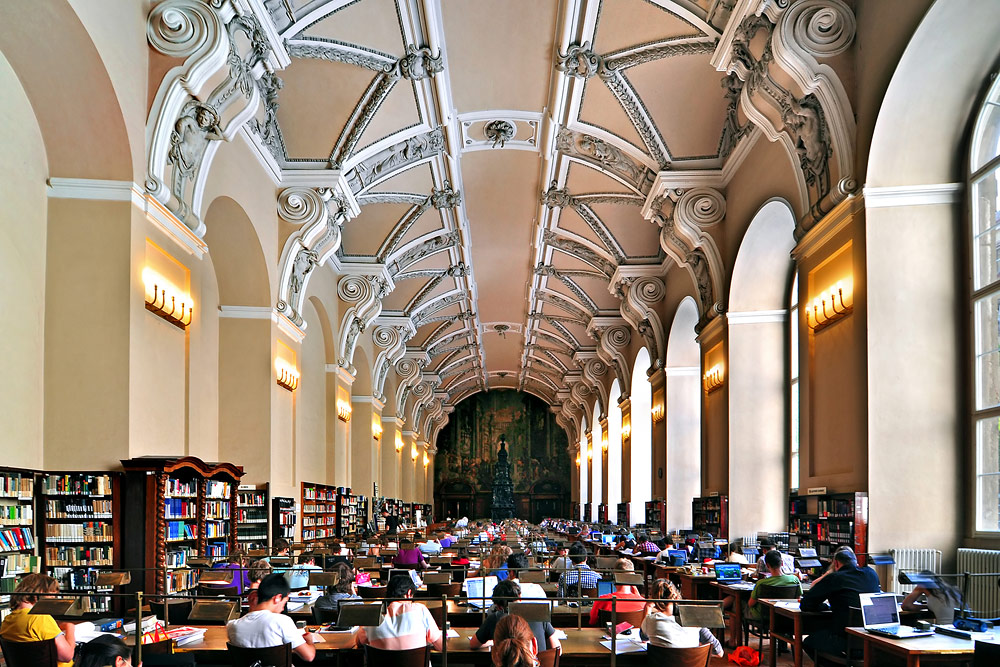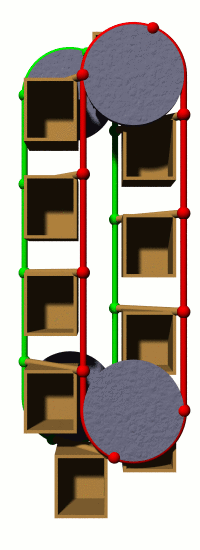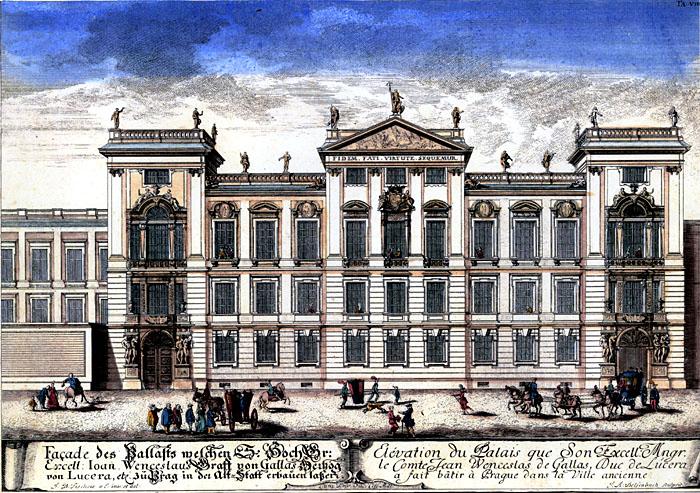|
Mariánské Náměstí
Mariánské náměstí (translated as ''Virgin Mary Square'') is a square in Old Town, Prague 1 in Czechia. It is surrounded by significant public buildings such Clementinum with National library, New City Hall with Mayor of the City of Prague residence and Prague City Council, Clam-Gallas Palace and Trauttmansdorff Palace. History Current name of the square is derived from extinct Church of Virgin Mary Na louži, which was placed next to the current Clam-Gallas Palace. In 20th century, the square began to be used as a big car parking space. In 2019, Prague City Council decided that the square will be turned into a pedestrian zone. Prague Institute of Planning and Development decided that Czech architectonic studio Xtopic will create a study about how the square should look like in the future. The rebuild should be done by 2024. From European Mobility Week European Mobility Week (shortened as EMW) is an annual initiative of the European Commission for Sustainable ... [...More Info...] [...Related Items...] OR: [Wikipedia] [Google] [Baidu] |
Prague
Prague ( ; cs, Praha ; german: Prag, ; la, Praga) is the capital and largest city in the Czech Republic, and the historical capital of Bohemia. On the Vltava river, Prague is home to about 1.3 million people. The city has a temperate oceanic climate, with relatively warm summers and chilly winters. Prague is a political, cultural, and economic hub of central Europe, with a rich history and Romanesque, Gothic, Renaissance and Baroque architectures. It was the capital of the Kingdom of Bohemia and residence of several Holy Roman Emperors, most notably Charles IV (r. 1346–1378). It was an important city to the Habsburg monarchy and Austro-Hungarian Empire. The city played major roles in the Bohemian and the Protestant Reformations, the Thirty Years' War and in 20th-century history as the capital of Czechoslovakia between the World Wars and the post-war Communist era. Prague is home to a number of well-known cultural attractions, many of which survived the ... [...More Info...] [...Related Items...] OR: [Wikipedia] [Google] [Baidu] |
Old Town (Prague)
The Old Town of Prague ( cs, Staré Město pražské, german: Prager Altstadt) is a medieval settlement of Prague, Czech Republic. It was separated from the outside by a semi-circular moat and wall, connected to the Vltava river at both of its ends. The moat is now covered up by the streets (from north to south-west) Revoluční, Na Příkopě, and Národní—which remain the official boundary of the cadastral community of Old Town. It is now part of Prague 1. Notable places in the Old Town include Old Town Square and Astronomical Clock. The Old Town is surrounded by the New Town of Prague. Across the river Vltava connected by the Charles Bridge is the Lesser Town of Prague ( cs, Malá Strana). The former Jewish Town (Josefov) is located in the northwest corner of Old Town heading towards the Vltava. History From its early existence, around the 9th century, Staré Město was laid out of settlements which appeared from the spacious marketplace on the bank of Vltava. R ... [...More Info...] [...Related Items...] OR: [Wikipedia] [Google] [Baidu] |
Prague 1
Prague 1, formally the Prague 1 Municipal District (), is a second-tier municipality in Prague. It is co-extensive with the national administrative district (''správní obvod'') of the same name. Prague 1 includes most of the medieval heart of the city. All of Staré Město (the Old Town) and Josefov (the Jewish Quarter) are in the district, as are most of Malá Strana (the Little Quarter), Hradčany and Nové Město (the New Town). Tiny parts of Holešovice and Vinohrady (the State Opera and new building of the National Museum) round out the district. The district has remained intact since its creation in 1960. Most of Prague 1 is a UNESCO World Heritage Site. Almost all of Prague's major tourist sites, including Prague Castle, Old Town Square, the Charles Bridge and the above-mentioned Jewish Quarter, are in the district. The Parliament of the Czech Republic and the offices of the government are in Malá Strana, while the main building of Charles University is in Staré Mě ... [...More Info...] [...Related Items...] OR: [Wikipedia] [Google] [Baidu] |
Czech Republic
The Czech Republic, or simply Czechia, is a landlocked country in Central Europe. Historically known as Bohemia, it is bordered by Austria to the south, Germany to the west, Poland to the northeast, and Slovakia to the southeast. The Czech Republic has a hilly landscape that covers an area of with a mostly temperate continental and oceanic climate. The capital and largest city is Prague; other major cities and urban areas include Brno, Ostrava, Plzeň and Liberec. The Duchy of Bohemia was founded in the late 9th century under Great Moravia. It was formally recognized as an Imperial State of the Holy Roman Empire in 1002 and became a kingdom in 1198. Following the Battle of Mohács in 1526, the whole Crown of Bohemia was gradually integrated into the Habsburg monarchy. The Protestant Bohemian Revolt led to the Thirty Years' War. After the Battle of White Mountain, the Habsburgs consolidated their rule. With the dissolution of the Holy Empire in 1806, the Cro ... [...More Info...] [...Related Items...] OR: [Wikipedia] [Google] [Baidu] |
Clementinum
The Clementinum (''Klementinum'' in Czech) is a historic complex of buildings in Prague. Until recently the complex hosted the National, University and Technical libraries; the City Library was also nearby on Mariánské Náměstí. In 2009, the Technical library and the Municipal library moved to the Prague National Technical Library at Technická 6. It is in use as the National Library of the Czech Republic. In 2005, the Czech National Library received the UNESCO Jikji prize (Memory of the World). History Its history dates from the existence of a chapel dedicated to Saint Clement in the 11th century. A Dominican monastery was founded in the medieval period, which was transformed in 1556 to a Jesuit college. In 1622 the Jesuits transferred the library of Charles University to the Klementinum, and the college was merged with the University in 1654. The Jesuits remained until their suppression in 1773, when the Klementinum was established as an observatory, library, and univer ... [...More Info...] [...Related Items...] OR: [Wikipedia] [Google] [Baidu] |
National Library Of The Czech Republic
The National Library of the Czech Republic ( cs, Národní knihovna České republiky) is the central library of the Czech Republic. It is directed by the Ministry of Culture. The library's main building is located in the historical Clementinum building in the centre of Prague, where approximately half of its books are kept. The other half of the collection is stored in the district of Hostivař. The National Library is the biggest library in the Czech Republic, housing around 6 million documents. The library currently has around 20,000 registered readers. Although comprising mostly Czech texts, the library also stores older material from Turkey, Iran and India. The library also houses books for Charles University in Prague. History In the 13th century, the ''Studium generale'' school was founded in the Dominican monastery in Prague's Old Town. This school, including its library, merged with the university in the 14th century. In 1556, monks of the Jesuit Order erected a boardi ... [...More Info...] [...Related Items...] OR: [Wikipedia] [Google] [Baidu] |
New City Hall (Prague)
Prague New City Hall (Czech: ''Nová radnice''), the central administrative building of Prague (not to be confused with the New Town Hall/''Novoměstská radnice'', once the town hall of Prague's New Town and now the building of the city district Prague 2), is located on the east side of '' Mariánské náměstí'' (Virgin Mary Square) in the centre of the Old Town, Prague 1, across from the Clementinum building complex. Since 1945 it has been the seat of Prague City Hall, Prague City Council, Prague City Assembly and the Mayor of Prague. The building contains offices, meeting halls and formal residences for the mayor and other city officials. History The hall stands on Virgin Mary Square. This was the site of a Romanesque church until 1798. In 1904 the city council announced a competition to design a new ''Radnice'' (city hall). The architect Osvald Polívka was announced as the winner in 1906. The new ''Radnice'' was constructed from 1908 - 1911 based on Polívka's Art ... [...More Info...] [...Related Items...] OR: [Wikipedia] [Google] [Baidu] |
List Of Mayors Of Prague
The office of Mayor of Prague was established in 1784. In that year, under Joseph II Joseph II (German: Josef Benedikt Anton Michael Adam; English: ''Joseph Benedict Anthony Michael Adam''; 13 March 1741 – 20 February 1790) was Holy Roman Emperor from August 1765 and sole ruler of the Habsburg lands from November 29, 1780 un ..., the four previously independent neighbouring communities of Malá Strana, Nové Město, Staré Město, and Hradčany were merged into a single entity. Since 1945, the mayor resides and presides in the New City Hall (on Mariánské Square), completed in 1911. Burgomasters of the Royal City of Prague (1784–1882) Mayors of the Royal City of Prague (1882–1918) Mayors of Prague (1918–present) References External links *{{Commons category-inline, Mayors of Prague ... [...More Info...] [...Related Items...] OR: [Wikipedia] [Google] [Baidu] |
Prague City Council
The Prague City Council, officially the Council of the Capital City of Prague ( cs, Rada hlavního města Prahy (RHMP)), is the executive body of Prague, the capital city of the Czech Republic. It is appointed by the Prague City Assembly, who elects the council from their own members. The council has 11 members, including the Mayor of Prague, four deputy mayors, and six other councillors. Council meetings are held every Tuesday, or otherwise as needed, and, unlike assembly meetings, are closed to the public. Minutes are taken of the meeting, which every citizen has the right to inspect. According to the Act on the Capital City of Prague, the law regulating the government of Prague, the Prague City Council has a similar purpose, status and power as a municipal council and a regional council in the Czech Republic. This is because the Capital City of Prague is a separate type of territorial self-governing entity and is therefore neither a region nor a municipality A municipality ... [...More Info...] [...Related Items...] OR: [Wikipedia] [Google] [Baidu] |
Clam-Gallas Palace
The Clam-Gallas Palace ( cs, Clam-Gallasovský palác) is a Baroque palace in Prague, the capital of the Czech Republic. The building is situated on the corner of Husova Street and Mariánské Square, in Prague Old Town. History The palace was first designed by the imperial court architect Johann Bernhard Fischer von Erlach, from Vienna. It was built in 1714–18 by the Italian architect Domenico Canevale. During the rest of the 18th century, Jewish balls and concerts were held in the palace, and were attended by noteworthy artists including Mozart and Beethoven. The Clam–Gallas Palace was built for the Viceroy of Naples, Count John Wenceslaus of Gallas. The Gallas family died out in 1757, and at that point the palace was inherited by Kristian Filip of Clam, son of Gallas' sister, which is how the Clam-Gallas family was created. The palace is now owned by the City of Prague which lends it to the Prague City Archives. Besides, since 2010 a multi-genre festival named "Opera ... [...More Info...] [...Related Items...] OR: [Wikipedia] [Google] [Baidu] |
Trauttmansdorff Palace
Trauttmansdorff Castle is a castle located south of the city of Meran, South Tyrol, northern Italy. It is home to the Touriseum, a museum of tourism and since 2001 the surrounding grounds have been open as the Trauttmansdorff Castle Gardens, a botanical garden. During the years of fascist Italy the castle was called ''di Nova Castle'' (''Torrente Nova'' is the name of a little brook A brook is a small river or natural stream of fresh water. It may also refer to: Computing *Brook, a programming language for GPU programming based on C *Brook+, an explicit data-parallel C compiler *BrookGPU, a framework for GPGPU programming ... near Trauttmansdorff). References External links Castles in South Tyrol Merano Tourism museums {{Italy-castle-stub ... [...More Info...] [...Related Items...] OR: [Wikipedia] [Google] [Baidu] |
Kostel Panny Marie Na Louži
{{geodis ...
Kostel may refer to: * Kostel, Kostel, a settlement in the Municipality of Kostel, Slovenia * Municipality of Kostel, Slovenia * Kostel, Croatia, a village near Pregrada, Croatia * Kostel, German name of the Czech town of Podivín * Kostel Pribićki, a village near Krašić, Croatia * Kostel, Bulgaria, a village in Elena Municipality * Pietrapelosa Pietrapelosa ( hr, Kostel, Kaštel, Kosmati grad, Kosmati Kostel, Kosmati Kaštel) is a castle in the Croatian part of Istria, now ruined. In the medieval period a family took their name from the castle. "Pietrapelosa" comes from the Italian words ... [...More Info...] [...Related Items...] OR: [Wikipedia] [Google] [Baidu] |






